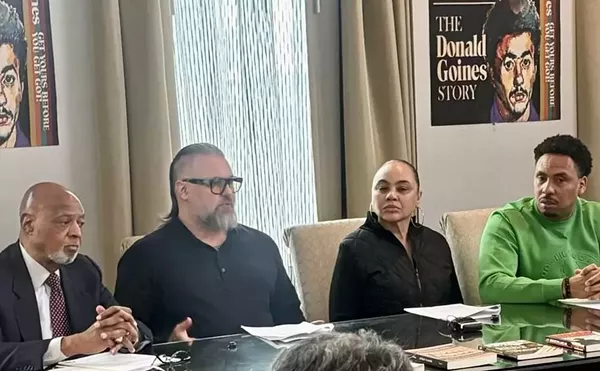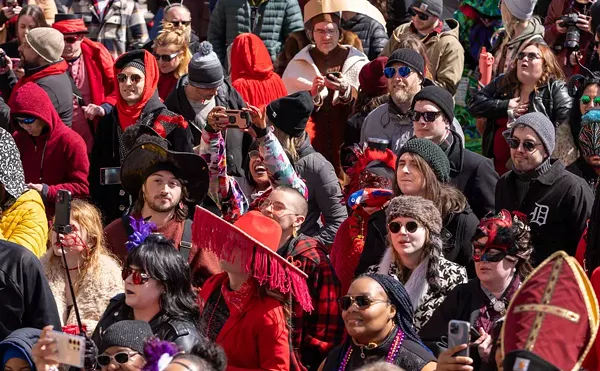Maurice Greenia Jr. is an American surrealist. Not just an artist influenced by surrealism — there have been thousands of those this side of the Atlantic, including many of our best, from Mark Rothko to Louise Bourgeois to Elizabeth Murray — but a dyed-in-the-wool fellow traveler on the road to the uncanny.
Greenia’s improbable images, whether spun by demented nouns in prose poems or twisted in wildly layered drawings, morph the real into a painful dream of itself. They pile up signs of life, echoes of death, waves of color and vectors of distortion to create a chain of parallel universes. They portray Detroit or Afghanistan or the far side of the moon with equal doses of curious compassion.
This explorer of the unimaginable in art, writing, puppetry and music was born in Detroit on Oct. 20, 1953 (“the same day as Arthur Rimbaud,” Greenia is quick to point out) and completed a degree in communications at the University of Detroit in 1976, the year he also began encountering the paintings of Picasso, Miró, Max Ernst, André Masson and Arshile Gorky among many of his other heroes:
“I started studying books about art history,” he recalls, “and got into surrealism especially, also Art Brut, Dada and abstract expressionism. In my childhood, I’d always sketched a lot, just doodled, but then I got the bug, started painting around ’77 and started showing my work in galleries around 1980.”
With his latest visions presently on display in two different one-man shows, Greenia pauses to remember his longtime friend and promoter, Jacques Karamanoukian, who passed away May 14 at the age of 62 in Paris:
“He was a freelance curator, promoting shows in different spaces. He included my work in a show near Bordeaux — there were 20 artists in it. I was the only American — the rest were from Europe and Africa. My French wasn’t that good, so we communicated by drawing pictures for each other.
“Jacques brought me over there for two weeks in 1996, showed me around Paris for a week and then I’d go around by myself, exploring. In 1999, he put me in another group show called ‘Dionysus in Paris: Outsiders, Aliens and Exiles’ along with work by Detroit artists Sam Mackey [Tyree Guyton’s late grandfather], Jim Puntigam and Karl Schneider.
“He had a salon scene up in Ann Arbor at his place called Galerie Jacques. There’d be readings there and he always tried to respect the poets, paying them out of his own pocket.”
Greenia (or Maugré, as he signs his works) is perennially grateful and soft-spoken and endlessly interested in the world. He tends to think of Detroit as a metaphor for the surrealist experience:
“The void, the empty spaces remind me of Tanguy, the endless horizons of di Chirico — all the steam coming out of the grates,” Greenia laughs.
The quiet humor of his conversation carries over to even the direst of his tableaus, such as Assembled Figures, a black-and-white drawing that combines biting cartoonlike caricature and abstract-expressionist delirium. The industrial-organic combine of Flower Factory (pictured) is an elbow in the ribs of Detroit’s technological obsessions, sending our hollow repressed laughter echoing down the corridors of the future.
Though Greenia’s works are never pretty, there are paintings in the ZeitGeist show that are jaggedly beautiful. Broken Landscape, for instance, evokes the brilliant “excavation” phase of Willem de Kooning’s work, and War Drawing/WWIII uses a colorful palette to frame a terminally grim scenario. As the characters in Greenia’s Erased Comic Strip (“Total Destruction Funnies”) say snidely to each other: “Let’s make with the ruining.” “Yes, time for smashing.”
In Greenia’s current show at the University of Detroit Mercy, a large drawing features one of his poetic texts:
“In this poor battered up dreamland there are no sleeping children. Here we find only the most imprecise sort of monsters. Their pockets are full of ashes. Their tongues tell only lies.”
It’s a typically transparent example of the unsettling realizations that Maugré (the French combined Greenia’s first and last names, baptizing him with this moniker that’s also an old French word meaning “to display ill will in a defiant manner”) turns out prolifically and unapologetically:
“I just always try to follow my own path, the way Jacques taught me, even if you’re out of fashion with the contemporary art scene. It’s out of style these days to do that.”
No, not unstylish, just extraordinary.
Maurice Greenia’s two latest shows are “Art Therapy for a Sick World” (through June 29 at ZeitGeist, 2661 Michigan Avenue, Detroit — 313-965-9192 — www.zeitgeistdetroit.org) and the installation at the University of Detroit Mercy Library (throughout the summer at Livernois and McNichols, Detroit — 313-993-1795).
George Tysh is Metro Times' arts editor. E-mail him at [email protected]





